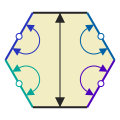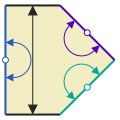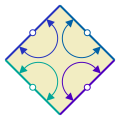Symmetry Relationships
This chart shows how tessellation symmetries are related. Rows show symmetry groups, columns show base polygons, and cells show tessellation symmetries (labeled by Heesch type).
For example, the cell in row "2-way" and column "Hexagons" shows that one tessellation symmetry is based on 2-way hexagons—TCCTCC (Hexagons, rotated).

Some cells are empty; for example, no tessellation symmetries use 4-way hexagons. And some cells are crowded; for example, three different tessellation symmetries use 4-way quadrilaterals with some tiles flipped.
(Note – symmetries with an internal mirror are not shown.)
Conversions
Lines show how a symmetry can be converted to another by removing (or adding) sides of its base polygon.
For our example TCCTCC:
- Removing a rotated edge (C) from the base hexagon gives TCTCC (Pentagons, rotated).
- Removing the pair of translated edges (T) gives CCCC (Quadrilaterals, rotated).



You can experiment with conversions yourself on any symmetry page. For example, go to Hexagons, rotated, and eliminate an edge by dragging a vertex (corner point) to an adjacent vertex. The remaining edges show a related symmetry.